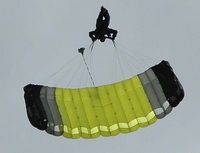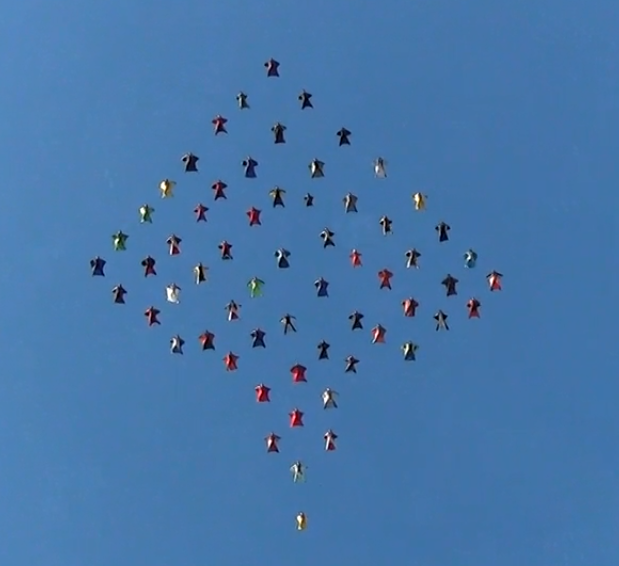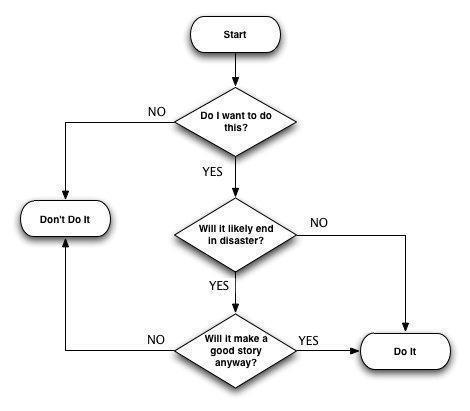Recommended Posts
strop45 0
I think you are completely, but understandably wrong on this one. Bit like BG and the 45 degree rule....
spootch 0
QuoteWhy should the position over the ground have any significance at all? I really don't get it. The only thing that is important is if the canopies are close together, i.e. the risk of a collision.
I think you are completely, but understandably wrong on this one. Bit like BG and the 45 degree rule....
LOL no, the theory is right but upon opening, makes it moot. At 80 kts even if a canopy held into the wind they are still going 60 kts backward....errrr forwards backwards...... and have lost whatever 10 seconds of altitude during canopy flight.....errrr assuming everyone opened at the same altitude.... which never happens... rendering that instance moot. Of course what we can all agree on is purple is a fantastic color ! ......errrr
billvon 2,384
No, you're not. The case is identical (from the jumper's perspective) of jumping in zero wind. Whatever separation you have in zero wind you have in 80 knots.
>How far are you going to drift in 10 seconds under canopy in 80 kts?
1340 feet. Are you comfortable opening 1340 feet from someone else? I am.
Now let's look at the zero wind case. Plane moves 134 feet per second over the ground between groups. Opening separation is thus 1340 feet.
Are you comfortable with a 10 second delay in zero winds?
>With the wind? Against the wind? Are you comfortable with that opening
>separation?
Yep. If you fly your canopy towards the next group you will decrease the separation. If you fly it away you will increase the separation. Just as in the zero wind case.
billvon 2,384
It doesn't. All you care about is the airspeed of the airplane and the relative speed of the winds at opening altitude.
BUT (and this is a very important but) winds at opening altitude are generally closer to zero, and the ground is (of course) moving at zero speed. So if you assume that the winds at opening altitude are moving the same speed as the ground (usually a reasonable assumption) then groundspeed is useful to know.
Guessing and hypothesizing doesn't work...do the math
Now summarize and simplify for the youngsters.
I'll do it:
1 kt = 6000ft
80kts per hr = 480000 feet per hour
Divide by 60 = 8000 feet per minute
Divide by 60 = 133.33 feet per second
133.33 feet per second for 10 seconds = 1333 feet
Canopy drift at 80 kts with no input and no forward drive for 10 seconds is 1333 feet.
(EDITED TO ADD: assuming an instantaneous horizontal speed starting at opening as opposed to a gradual acceleration to speed as per reality)
Yes, one would love that.
Plenty of separation for the next group to open.
And we didn't address the little bit of much less important horizontal separation.
Everybody: Be careful with blatant statements to the youngsters. Prove to them what's up.
EDITED TO ADD:
Now, in reality, you need to be careful with zero ground speed separation. Bill's example is an extreme one that we should never face in reality.
Always do the math and you won't go wrong.
And yes, before anybody goes off on that "Nuh Uh" tangent...your calculations are only as good as the validity of the numbers you put unto it.
I think we're all Bozos on this bus.
Falcon5232, SCS8170, SCSA353, POPS9398, DS239
dpreguy 14
You guys are complicating a simple matter with your 'layers' discussions. The layers don't mean a thing. The example of a plane going 80 with headwinds at 80, and getting adequate separation with 10 seconds between groups is misleading. (not moving over the ground at all) Both of you guys are operating upon the incorrect theory that if a skydiver is in 80 knot wind while in freefall he will be going 80 knots over the ground. Not so. Not even close. We do get some freefall drift, but not nearly at the rate that the wind is blowing. A piece of tissue paper maybe, but a heavy body won't even come close.
This thread started out with the statement that"...winds stronger at the top, gradually decreasing on the way down, a group in a a highr moving layer of air will spend the whole freefall moving closer to a group in a slower moving layer."
Of course that is true, but the statement is only true if the two groups didn't come out of the same airplane. The discussion following seemed to state that successive groups would be affected in dissimilar manners by these layers. Not a good premise. It is not true that groups following out of the same aricraft, will "tend to pile up on each other because of layers". Not true at all, because the same layers affect all in the same manner. That is why groundspeed, or maybe a better way to say it, "ground distance between groups" is the only determinor of where groups will end up relative to each other at opening point. Groundspeed is used because that is the only way a skydiver, equipped with groundspeed info ,can make an educated guess about exit intervals. On a day with negligble airspeed at altitude, in a king air for example going about (shoot I don't know exactly ...I use 88 feet er second for 60 mph) , maybe 150 feet per second, (maybe 95 knots) abut 6 or 7 secods leaves the groups 1000 feet apart at opening. If the groundspeed is half of 95, then it is an easy fix to just double it and allow 14 or so seconds between groups. Same 1000 foot separation at exit and the same separation at opening, because the groups leave at the same ground distance from each other. It is a simple concept with an easily computed solution; one you can do in your head in the airplane with normal headwinds on jump run. Say up to 50 knots, you can do it in your head.
OK, I agree when the groundspeed approaches zero, it can't be calculated in one's head. No one can really get separation even though a decently long delay between groups may be used. Yes, groups will achieve a 'bit' of separation from freefall drift due to strong winds and the time interval, but NOT at the rate of (example 80 knots: 80 knots times 10 seconds.) The time interval will give some 'some' freefall drift, but since we aren't tissue paper, this freefall drift over the ground will never approach the (example 80 knots) speed of the wind itself. Not even close. So, the 10 seconds between groups -80 knot example giving adequate separation is not true, because we are heavy objects. 10 seconds, at 80 knots headwinds would leave all groups very very very close at 2500 feet.
So, I suggest forgetting all of this layer stuff. It means nothing, as all succeeding groups are going thru the same layers, affecting all groups exactly the same.
Judging actual (ground distance) separation between groups following each other is as simple as getting groundspeed, which our pilot announces when it gets at all strong, and figuring out what gives 1000 feet of separation at opening.
All of the discussions of what it all "looks like" and "45 degree angle" "looking out the door" and stuff is also a distraction. The objective here is getting separation at opening. That is as simple as getting across the ground the same distance between groups, regardless of the winds encontered by the airplane. The slower the groundspeed, the longer the time interval= that amount of time sufficient to cover the 1000 feet or whatever is desired across the ground itself. This isn't difficult.
kallend 1,621
QuoteQuoteIf you can't imagine how a zero groundspeed could possibly give you enough separation - think about what a jumper who just opened would see when they looked at the airplane, the ground and the next jumpers to come along. Remember the wind is 80 knots all the way down. Also remember that parachutes don't go 80 knots.
What one would see is some bozo opening up right next to him. How far are you going to drift in 10 seconds under canopy in 80 kts? With the wind? Against the wind?
On average, 1350 feet.
The only sure way to survive a canopy collision is not to have one.
kallend 1,621
Quoteskr and bilvon
You guys are complicating a simple matter with your 'layers' discussions. The layers don't mean a thing. The example of a plane going 80 with headwinds at 80, and getting adequate separation with 10 seconds between groups is misleading. (not moving over the ground at all) Both of you guys are operating upon the incorrect theory that if a skydiver is in 80 knot wind while in freefall he will be going 80 knots over the ground. Not so. Not even close. We do get some freefall drift, but not nearly at the rate that the wind is blowing. A piece of tissue paper maybe, but a heavy body won't even come close.
.
Someone is practicing physics without a license. It only takes around 6-8 seconds to come into equilibrium with the wind speed.
The only sure way to survive a canopy collision is not to have one.
kallend 1,621
QuoteGood stuff! I finally got somebody to put up some type of numbers to back up what they were saying to show the youngsters what you are talking about with the separation and wind speed at opening.
Some of us have been putting up numbers since the rec.skydiving days.
Unfortunately there are too many people who don't take the time or make the effort to read them.
The only sure way to survive a canopy collision is not to have one.
billvon 2,384
> skydiver is in 80 knot wind while in freefall he will be going 80 knots over
>the ground.
He will in fact be going 80 knots over the ground. (Unless he's tracking of course.)
Surely you do not believe that when you jump in strong winds you feel a "side breeze" on you when you are just trying to fall straight down.
>So, I suggest forgetting all of this layer stuff. It means nothing, as all
>succeeding groups are going thru the same layers, affecting all groups
>exactly the same.
Normally ignoring the "layer stuff" doesn't do any harm. If winds are zero at opening altitude you get normal separation; if they are not zero but are the same direction as you have at altitude you get more separation - and no one complains about too much separation.
The one time it does NOT work is when winds at opening altitude are opposite winds at exit altitude. When that happens you must increase exit separation even further. We used to have this happen at Otay when Santa Anas were coming in; some days we'd need 30 seconds between groups.
QuoteThe one time it does NOT work is when winds at opening altitude are opposite winds at exit altitude. When that happens you must increase exit separation even further. We used to have this happen at Otay when Santa Anas were coming in; some days we'd need 30 seconds between groups
This is what I was getting at before...It is the only time 'layers' of wind become relevant in deciding exit separation.
Normal scenario -
Uppers = 25 knots 360degrees
Lowers = 10 knots 340degrees
Jump run = 360
In this scenario layers of wind are negligible - they have no effect on separation (this was the initial topic wasn't it?). If Jumper B leaves 1,000ft of separation at exit (however you want to calculate it) he will have 1,000 ft of separation from jumper A at deployment. Both jumpers experience the same wind on the way down the only variable is the amount of time spent in free-fall and the amount of free fall drift they inherit...slower jumpers out first etc
Opposite wind scenario -
Uppers - 25knots 360
Lowers = 10 knots 180
Jump run 360
In this scenario wind layers are relevant for separation, but it does not change the way we estimate it...It is still all about ground speed. In the lower winds Jumper A may drift (both under canopy and in FF) back towards the free fall path of Jumper B. Given that jumper B has left 1,000ft of separation at exit it is VERY unlikely that jumper A will close that initial separation. It would seem smart however to allow just that bit extra to be sure.
EDIT - I also agree that this thread has complicated a simple topic. Separation should be the easy part (jumpers are all relative to each other). Spotting from 14K is the part that requires a bit more thought.
dpreguy 14
Nope. Not at all true. False assumptiion. Nor does a sailboat ever reach the speed of the wind on a downwind. Not even close to it. Anyway, that was only the "80 knots headwind-80 knot airplane" example. Just a side scenario anyway
The 'layers' thing is the discussion without fruit.
In regard to the groundspeed technique: the calculations of groundspeed thing works, and has been working for a long time.
QuoteSome of us have been putting up numbers since the rec.skydiving days..
And some of us appreciate it.
I think we're all Bozos on this bus.
Falcon5232, SCS8170, SCSA353, POPS9398, DS239
kallend 1,621
Quote"6-8 seconds to reach equalibrium"
Nope. Not at all true. False assumptiion.
WRONG.
You are out of your depth on this one.
The only sure way to survive a canopy collision is not to have one.
QuoteNor does a sailboat ever reach the speed of the wind on a downwind. Not even close to it.
That is not a good analogy because the boat is slowed by significant drag caused by the hull passing through the water.
QuoteQuote"6-8 seconds to reach equalibrium"
Nope. Not at all true. False assumptiion.
WRONG.
You are out of your depth on this one.
Arguing physics with a physics professor.....
Kallend, going to regale us rigging knowledge?
*popcorn, yadda yadda*
billvon 2,384
>Lowers = 10 knots 340degrees
>Jump run = 360
>In this scenario layers of wind are negligible - they have no effect on separation
Well, sort of. They increase separation, so if you ignore them you are in good shape - you get more distance than you bargained for. Not much; in the above example the winds at opening altitude are only giving you another 150 feet if you wait 10 seconds between groups.
>Uppers - 25knots 360
>Lowers = 10 knots 180
In this case you lose that 150 feet. If the jumpers left plenty of time at exit it's probably not a big deal.
Those winds you give are pretty typical which is why most of the time groundspeed works for estimating exit separation. If you only gain or lose 150 feet due to winds at opening altitude, and you always pad your separation a bit, and the winds at opening are either zero, from the same direction or are _light_ from the opposite direction, then groundspeed is a good way to estimate separation.




.thumb.jpg.4bb795e2eaf21b8b300039a5e1ec7f92.jpg)



What one would see is some bozo opening up right next to him. How far are you going to drift in 10 seconds under canopy in 80 kts? With the wind? Against the wind? Are you comfortable with that opening separation?
IF the opening winds are so fantastically fast as to push your canopy in 10 seconds about 500 feet or more away from my canopy opening from the next group in the same spot....meh, I'd agree with you.
Let me know when the winds are such. I have a solution for that.
I think we're all Bozos on this bus.
Falcon5232, SCS8170, SCSA353, POPS9398, DS239
Share this post
Link to post
Share on other sites